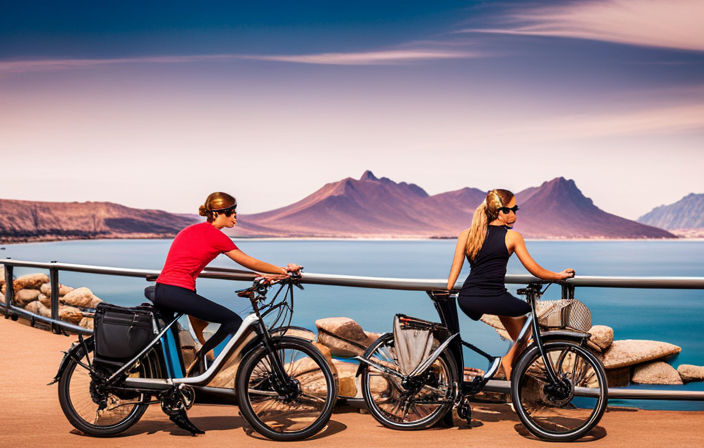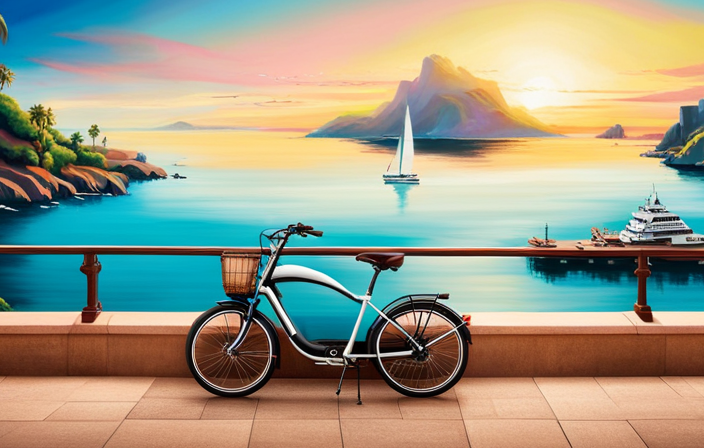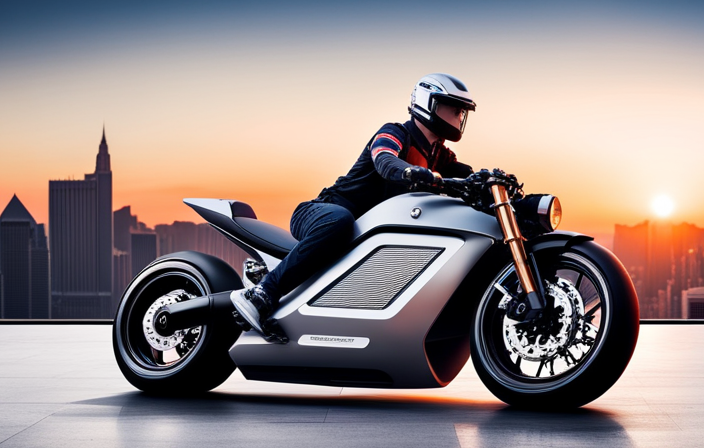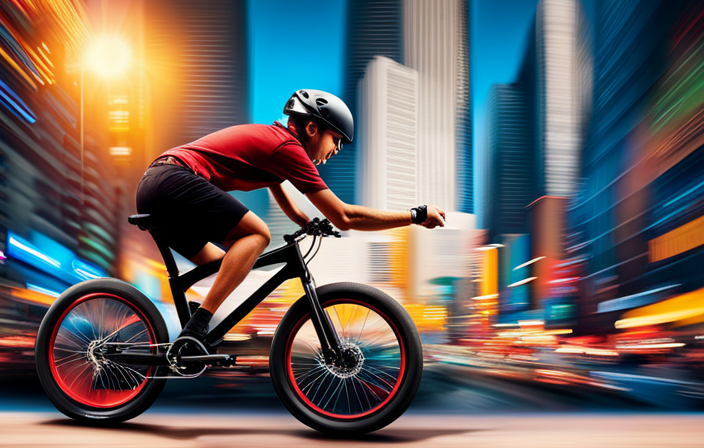Did you know that the range of your electric bike can be affected by several factors?
In this article, I’ll explore how battery capacity, motor efficiency, rider weight, terrain, riding style, and more can impact how far your electric bike can go on a single charge.
By understanding these factors and making informed decisions, you’ll be able to maximize the range of your electric bike and enjoy longer rides without worrying about running out of battery power.
Let’s dive in and discover just how far your electric bike can take you!
Key Takeaways
- Battery capacity, specifically higher capacity, results in longer battery life and increased range.
- Rider factors such as weight distribution, leaning forward, and reducing personal weight can improve motor efficiency and increase range.
- Terrain and riding style, such as riding uphill or at high speeds, can consume more power and limit the distance an electric bike can travel.
- Different assistance levels and proper gear shifting can conserve battery power and increase stamina, while maintaining an efficient cadence.
Battery Capacity and Type
It’s important to consider the battery capacity and type when determining how far your electric bike will go. The battery life of an electric bike is crucial in determining the range it can cover on a single charge. A higher battery capacity will generally result in a longer battery life and allow you to travel further distances.
Additionally, the type of battery used can also impact the overall performance. Lithium-ion batteries are known for their high energy density and longer lifespan compared to other types of batteries.
Charging time is another factor to consider. Faster charging times mean less downtime and more time on the road. By carefully considering the battery capacity, type, and charging time, you can ensure that your electric bike will have the necessary power to take you on longer rides.
Speaking of power, let’s now delve into the next aspect of electric bike performance: motor efficiency.
Motor Efficiency
When it comes to choosing an electric bike, one key point to consider is the motor efficiency. Opting for a bike with a high-efficiency motor can greatly impact the overall performance and range of the bike.
Understanding how motor power affects the range is crucial in making an informed decision. A more powerful motor may consume more energy and reduce the distance you can travel on a single charge.
Choose a bike with a high-efficiency motor
Choosing a bike with a high-efficiency motor is crucial for maximizing the range of your electric bike. A high-efficiency motor will convert more electrical energy into mechanical power, resulting in better performance and longer range. When selecting an electric bike, it is important to consider the efficiency of the motor. Additionally, implementing energy efficient riding techniques can further enhance your e-bike’s range. These techniques include maintaining a steady speed, avoiding unnecessary acceleration and deceleration, utilizing regenerative braking, and keeping your bike well-maintained. By choosing a bike with a high-efficiency motor and practicing energy efficient riding techniques, you can significantly increase the distance your electric bike can travel before needing to recharge. Understanding how motor power affects range is the next important aspect to consider.
Understand how motor power affects range
Understanding how motor power affects the range of an e-bike is crucial for maximizing its performance. The motor power efficiency is a key factor in determining how far the e-bike can go on a single charge. A higher motor power efficiency means that the motor can convert more electrical energy into mechanical power, resulting in a longer range. On the other hand, a lower motor power efficiency will result in a shorter range.
It is also important to consider the impact of rider weight on the range of an e-bike. Heavier riders require more power from the motor to propel the bike, which can reduce the overall range. By understanding the relationship between motor power and range, as well as the impact of rider weight, riders can make informed decisions to optimize the performance of their e-bikes.
Moving on to the impact of rider weight…
Rider Weight
When it comes to electric bikes, rider weight plays a crucial role in determining the range you can achieve.
In this discussion, we will explore how the weight of the rider impacts the overall range of the electric bike.
Additionally, I will share some useful tips for reducing rider weight on the bike, allowing you to maximize the efficiency and performance of your electric ride.
Explore how rider weight impacts range
Rider weight affects the range of an electric bike. The distribution of rider weight plays a crucial role in determining how far the bike can go on a single charge. When the weight is evenly distributed, the bike’s motor works more efficiently, resulting in better range. On the other hand, if the rider’s weight is concentrated towards the front or back of the bike, it can negatively impact the range.
Additionally, the posture of the rider also affects the range. Leaning forward reduces wind resistance, allowing the bike to travel further. Conversely, sitting upright creates more drag, reducing the overall range.
Understanding the impact of rider weight distribution and posture is essential in maximizing the range of an electric bike. By optimizing these factors, riders can increase their bike’s range and enjoy longer rides.
Now, let’s explore some tips for reducing rider weight on the bike.
Learn tips for reducing rider weight on the bike
To maximize range, it’s important to find ways to reduce the weight you carry on the bike. One effective method is to focus on reducing your own weight. By adopting a healthier lifestyle and reducing calories, you can shed those extra pounds that can weigh you down during your ride.
Additionally, investing in lightweight gear can significantly decrease the overall weight of your bike. Look for materials such as carbon fiber or aluminum when choosing components like handlebars, seat posts, and frames. Opting for lighter tires and accessories can also make a difference.
By taking these steps to reduce rider weight and invest in lightweight gear, you’ll be able to maximize your electric bike’s range and enjoy longer rides.
Now, let’s dive into how terrain and elevation affect your bike’s range.
Terrain and Elevation
The terrain and elevation will affect how far your electric bike can go. When exploring incline challenges, it’s important to consider that riding uphill will require more power from your electric bike, which can significantly reduce its range. The steeper the incline, the more power it will consume, resulting in a shorter distance you can travel.
On the other hand, going downhill can have a positive impact on your range. When riding downhill, the electric motor can regenerate power through regenerative braking, which can help to recharge the battery and extend your overall distance.
Understanding how different terrains and elevations can impact your electric bike’s range is crucial for planning your rides and managing your battery power effectively.
Now, let’s discuss how your riding style and speed can influence the distance your electric bike can go.
Riding Style and Speed
When it comes to electric bikes, understanding how your riding style affects the range is crucial. By analyzing factors such as acceleration, braking, and overall speed, you can optimize your ride for maximum range.
In this discussion, we will delve into the different riding styles and techniques that can help you get the most out of your electric bike’s battery life.
Discover how riding style affects range
Your riding style greatly impacts how far your electric bike can go. Here are three key factors to consider:
-
Rider Technique: The way you ride your electric bike can significantly affect its range. Aggressive acceleration and braking consume more energy compared to smooth and gradual movements. By maintaining a steady speed and avoiding sudden bursts of power, you can conserve battery life and increase your overall range.
-
Impact of Terrain: The type of terrain you ride on also plays a crucial role in determining how far your electric bike can go. Uphill climbs and rough surfaces require more power, draining your battery faster. On the other hand, riding on flat terrain or downhill slopes allows for easier pedaling and less strain on the motor, resulting in extended range.
-
Efficient Gear Shifting: Proper gear shifting can optimize your electric bike’s performance and range. By using lower gears to tackle inclines and higher gears on flat or downhill sections, you can maintain an efficient cadence and minimize unnecessary energy expenditure.
Understanding these factors will help you make informed decisions to maximize the range of your electric bike.
In the next section, we will explore how to optimize your speed for maximum range.
Learn how to optimize your speed for maximum range
To optimize your speed for maximum range, it’s important to find a consistent and efficient pace. When riding an electric bike, there are several tips for increasing battery life and strategies for conserving energy.
One key tip is to maintain a steady speed instead of constantly accelerating and decelerating. This allows the battery to work more efficiently and helps to conserve energy.
Additionally, using the right gear ratio can also contribute to maximizing your range. It’s important to find the right balance between pedaling and utilizing the electric motor. By pedaling lightly and allowing the motor to assist you, you can conserve energy and extend your battery life.
Transitioning into the next section about assistance level, it’s also important to consider how adjusting the assistance level can impact your range.
Assistance Level
When it comes to maximizing the range of an electric bike, understanding the impact of different assistance levels is crucial. Each assistance level offers a varying degree of motor power and support, which directly affects how far you can go on a single charge.
Understand the impact of different assistance levels on range
Depending on the assistance level, your electric bike will go a different distance. This is determined by factors such as motor power and range optimization, as well as rider weight and battery capacity.
Let’s take a closer look at how these variables affect your e-bike’s range:
-
Motor Power: A higher motor power will provide more assistance, but it also consumes more battery energy. This can reduce the overall range of your electric bike.
-
Range Optimization: Some e-bikes offer different modes of assistance, such as eco, normal, and sport. Eco mode provides the least assistance but maximizes battery efficiency, resulting in a longer range.
-
Rider Weight: Heavier riders may experience a slightly shorter range due to increased energy demands on the motor and battery.
-
Battery Capacity: The size and capacity of the battery directly impact the distance your electric bike can travel. A larger battery capacity will typically result in a longer range.
Understanding these factors will help you make informed decisions about which assistance level to use for optimal range. By considering motor power, range optimization, rider weight, and battery capacity, you can maximize the distance your electric bike can go without compromising performance.
Learn when to use each assistance level for optimal range
Using different assistance levels on your e-bike can help you achieve the optimal range. It’s important to understand when to use each level depending on various factors such as rider stamina and battery range estimation.
For longer rides or when you want to conserve battery power, using a lower assistance level can be beneficial. This allows you to rely more on your own pedaling power, thus increasing your stamina and extending the battery range.
On the other hand, if you’re facing a challenging terrain or need an extra boost, using a higher assistance level can be advantageous. By adjusting the assistance level according to your needs, you can maximize your e-bike’s range and get the most out of your ride.
Now, let’s move on to another important factor for optimizing your e-bike’s range: tire pressure and condition.
Tire Pressure and Condition
Maintaining proper tire pressure and checking the condition regularly is essential for maximizing the distance your electric bike can go. Tire maintenance plays a crucial role in ensuring optimal performance and efficiency. By keeping your tires properly inflated, you reduce rolling resistance, which allows your electric bike to travel further with less effort. It is recommended to use a tire pressure gauge to monitor the tire pressure regularly and adjust it as needed. Additionally, inspecting the tires for any signs of wear, such as cracks or bulges, is important to prevent potential blowouts or punctures that could limit your bike’s range. Taking these steps to maintain your tires will not only extend the distance you can travel on a single charge but also contribute to a safer and more enjoyable riding experience.
Considering weather conditions, it is important to acknowledge how they can impact your electric bike’s range.
Weather Conditions
As an experienced rider, I understand the importance of considering weather conditions when planning my rides. Not only do weather conditions impact the range of my electric bike, but they also affect the overall riding experience.
In this discussion, I will share my insights on how different weather conditions can impact the range of an electric bike and provide useful tips for riding in various weather conditions.
Understand how weather conditions impact range
Rainy days can significantly reduce the range of my electric bike. When it’s wet outside, the water can damage the electrical components and make it harder for the motor to function optimally. Additionally, riding in the rain requires more energy due to the increased resistance from wet roads. To give you an idea of how different weather conditions can affect your electric bike’s range, take a look at the table below:
| Weather Condition | Impact on Range |
|---|---|
| Rainy | Reduced |
| Windy | Decreased |
| Cold | Decreased |
| Hot | Decreased |
Understanding the impact of weather conditions on your electric bike’s range is crucial for planning your rides. In the next section, we’ll learn tips for riding in different weather conditions, including windy conditions and how temperature affects range. So, let’s dive in and explore how to make the most of various weather conditions without compromising our riding experience.
Learn tips for riding in different weather conditions
Understanding how weather conditions affect your electric bike’s range is essential for optimizing your riding experience in different weather conditions.
One of the key factors to consider is wind resistance. Riding against strong winds can significantly reduce your bike’s range, as it requires more power to overcome the resistance. To minimize this effect, try to ride in sheltered areas or behind buildings or trees that can provide some protection from the wind.
Additionally, choosing appropriate clothing can help reduce wind resistance. Wearing tight-fitting clothes and a helmet with an aerodynamic design can help you ride more efficiently and improve your bike’s range.
By being mindful of wind resistance and selecting the right clothing, you can maximize the distance you can travel on your electric bike.
As we delve into the topic of accessories and attachments, let’s explore how these can further enhance your electric bike riding experience.
Accessories and Attachments
I’ve heard that adding accessories and attachments to your electric bike can greatly enhance your riding experience.
When it comes to accessories for comfort, there are a few key items to consider. First, a comfortable saddle can make a world of difference, especially on longer rides. Look for one with gel padding or ergonomic design.
Additionally, ergonomic handlebar grips can reduce hand fatigue and provide a more secure grip.
As for safety attachments for carrying, a sturdy rear rack is essential for transporting items. You can easily attach panniers or a basket to the rack, allowing you to carry groceries, a backpack, or even your pet. These attachments not only add convenience but also ensure that your ride is safe and enjoyable.
Speaking of safety, let’s now transition into the next section about route planning, where we’ll discuss how to choose the best routes for your electric bike adventures.
Route Planning
When it comes to maximizing the range of my electric bike, route planning plays a crucial role. By carefully selecting the most efficient routes, I can ensure that I make the most of my battery’s charge.
In this discussion, I will explore how route planning can help me go the extra mile and introduce various apps and tools that can assist in finding the optimal routes for my electric bike journeys.
Discover how route planning can maximize range
To maximize your electric bike’s range, plan your route carefully. Route optimization and energy-saving techniques are key to getting the most out of your electric bike’s battery. By considering factors such as distance, terrain, and traffic conditions, you can ensure a more efficient and enjoyable ride.
One way to optimize your route is by using a bike route planner or GPS navigation system. These tools can help you find the most direct and bike-friendly paths, avoiding busy roads and steep inclines. Additionally, they can provide real-time updates on traffic conditions, allowing you to choose alternative routes if necessary.
Another energy-saving technique is to take advantage of regenerative braking. This feature allows the bike to convert kinetic energy into electrical energy, which can be stored in the battery for later use. By utilizing regenerative braking when going downhill or coming to a stop, you can extend your electric bike’s range.
Learn about apps and tools for finding optimal routes
Using a bike route planner or GPS navigation system can help you find optimal routes for your electric bike. There are numerous apps available that offer navigation specifically designed for cyclists. These apps not only provide turn-by-turn directions, but also take into account factors such as terrain, traffic, and elevation to suggest the most efficient route for your electric bike.
Additionally, there are several tools for route optimization that can be used in conjunction with these apps. These tools analyze data such as distance, elevation, and road conditions to determine the most energy-efficient path for your electric bike. By using these apps and tools, you can maximize your electric bike’s range by avoiding unnecessary detours or challenging terrain.
Now, let’s delve into another important aspect of electric bike technology: regenerative braking.
Regenerative Braking
Regenerative braking is an important feature in electric vehicles that can greatly impact their range. By understanding how regenerative braking works, one can optimize its usage to maximize the distance traveled on a single charge.
In this discussion, I will delve into the mechanics of regenerative braking and provide tips on how to effectively utilize this feature to enhance the range of your electric vehicle.
Understand how regenerative braking affects range
The range of your electric bike can be affected by regenerative braking. While regenerative braking is a great feature that helps extend battery life and improve energy efficiency, it does have an impact on how far your bike can go on a single charge. When you engage the regenerative braking system, the electric motor acts as a generator, converting the kinetic energy of the bike’s motion into electrical energy that is stored in the battery. This process slows down the bike and helps recharge the battery, but it also consumes some energy in the process. Therefore, using regenerative braking excessively or on steep downhill slopes can reduce your bike’s range. To better understand how regenerative braking affects range, take a look at the table below:
| Regenerative Braking Level | Impact on Range |
|---|---|
| Low | Minimal |
| Medium | Moderate |
| High | Significant |
Learn tips for utilizing regenerative braking effectively
To get the most out of regenerative braking, it’s important to know when and how to apply it effectively. Maximizing efficiency is key when it comes to electric bike range, and using regenerative braking properly can help achieve that goal.
One technique for effectively utilizing regenerative braking is to anticipate when you will need to slow down or come to a stop. By releasing the throttle earlier and allowing the regenerative braking system to kick in, you can convert the kinetic energy of the bike into electrical energy, which is then stored in the battery. This not only helps to slow down the bike, but also charges the battery, maximizing efficiency.
Understanding the braking techniques and adjusting your riding style accordingly can greatly extend the range of your electric bike. By utilizing regenerative braking effectively, you can make the most of your electric bike’s capabilities and enjoy longer rides.
Speaking of battery management…
Battery Management
Battery life is a crucial factor when considering how far an electric bike can go. The battery is the lifeblood of the bike, determining the distance it can travel before needing a recharge.
Here are some key points to consider about battery life and charging time:
- Battery capacity: The larger the battery capacity, the longer the bike can go without needing a recharge.
- Power consumption: Factors like terrain, speed, and rider weight affect the power consumption and ultimately the battery life.
- Charging time: How long it takes to fully charge the battery varies depending on the charger and the battery’s capacity.
- Fast charging options: Some electric bikes offer fast charging options that can significantly reduce the charging time.
- Battery lifespan: Over time, the battery’s capacity may decrease, affecting its overall performance and range.
Understanding battery life and charging time is essential to maximize the distance you can travel on your electric bike.
Now, let’s delve into the importance of charging habits.
Charging Habits
When it comes to maximizing the distance you can travel on an electric bike, charging habits play a crucial role. Proper battery management is essential for getting the most out of your electric bike’s range.
One important charging habit is to always charge your battery fully before each ride. This ensures that you start with a full charge and can take advantage of the entire range of your electric bike.
Additionally, it is recommended to avoid deeply discharging the battery as this can reduce its overall lifespan. Regularly charging the battery, even if you haven’t used the bike, is also beneficial for maintaining its performance.
By following these charging habits, you can optimize the distance you can travel on your electric bike.
Now, let’s move on to maintenance and upkeep, which are equally important for maximizing your electric bike’s range.
Maintenance and Upkeep
When it comes to maintaining and keeping my electric bike in top shape, there are a few key practices that I follow to ensure that I can maximize its lifespan and minimize any maintenance costs.
Here are three important steps to consider:
-
Regular cleaning: Keeping the bike clean not only helps it look good, but it also prevents dust and dirt from accumulating and causing damage to the components.
-
Proper tire maintenance: Checking tire pressure regularly and ensuring that they are properly inflated can help reduce the risk of punctures and increase the overall efficiency of the bike.
-
Routine servicing: Just like any other vehicle, electric bikes require periodic servicing to keep everything running smoothly. This includes checking the brakes, gears, and battery health, as well as lubricating any moving parts.
By following these maintenance practices, I have found that I can greatly reduce the need for costly repairs and increase the lifespan of my electric bike.
Now, let’s move on to the exciting world of test rides and reviews.
Test Rides and Reviews
If you’re considering purchasing an electric bike, it’s important to read test rides and reviews to get a better understanding of its performance and reliability.
Test ride benefits are numerous, as they allow you to experience firsthand how the bike handles, accelerates, and brakes.
Reviews, on the other hand, provide valuable insights from other riders who have already tested the bike.
When researching popular electric bike models, it’s crucial to analyze the reviews for common issues or recurring praises.
Look for reviews that cover a wide range of riding conditions and terrains to get a comprehensive understanding of the bike’s capabilities.
Additionally, pay attention to the reviewer’s expertise and compare their experiences with other reviews to get a balanced perspective.
Taking the time to read test rides and reviews will greatly inform your decision-making process and help you find the electric bike that best suits your needs.
Frequently Asked Questions
Can I ride my electric bike in the rain or through puddles?
Yes, you can ride your electric bike in the rain or through puddles. However, it’s important to note that riding in snowy conditions may be challenging. Electric bikes do require maintenance in wet weather to ensure optimal performance and longevity.
How often should I charge my electric bike’s battery?
Charging frequency is crucial to ensuring optimal battery lifespan. To maximize your electric bike’s battery life, charge it regularly based on manufacturer recommendations. Neglecting this important task could lead to shorter battery lifespan and reduced overall performance.
Are there any restrictions or regulations on riding an electric bike?
When it comes to electric bike safety, it’s important to be aware of any restrictions or regulations in your area. This may include speed limits, which vary depending on the location. It’s always best to check with local authorities to ensure you’re riding within the law.
Can I ride my electric bike on steep hills?
When riding on steep hills, it’s important to use proper riding technique to maintain control and prevent accidents. Additionally, riding uphill can drain the battery faster, reducing its lifespan.
How long does it typically take to fully charge an electric bike’s battery?
Typically, it takes around 4-6 hours to fully charge an electric bike’s battery. However, the charging time can be affected by factors such as battery capacity, charger efficiency, and current battery level.
Conclusion
After considering all of the factors that can affect the range of an electric bike, it’s clear that there is no simple answer to the question of how far it will go. From the battery capacity and type, to the motor efficiency and rider weight, there are numerous variables at play.
Additionally, factors like terrain, riding style, and charging habits also come into play. The best way to truly know how far your electric bike will go is to take it for a test ride or read reviews from others who have experienced it firsthand.
So, buckle up and get ready for an electrifying adventure!









